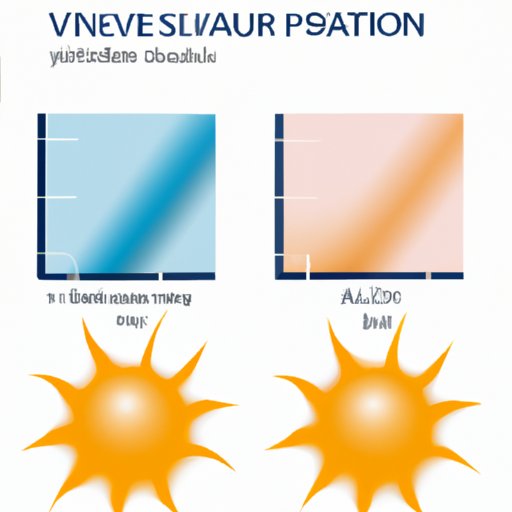
Introduction
Many of us associate sunburn with outdoor activities such as spending time at the beach or going for a hike. However, it may come as a surprise to learn that you can get sunburn even when you are indoors. In this article, we will explore whether you can get sunburn through a window, the different types of windows and how they block UV radiation, common myths and misconceptions about sunburns through windows, potential consequences of sunburn through windows, and tips for protecting oneself from sun exposure indoors.
Understanding UV Radiation
UV radiation, also known as ultraviolet radiation, is a form of electromagnetic radiation that comes from the sun. This type of radiation consists of three categories including UVA, UVB, and UVC, but only UVA and UVB rays can penetrate the skin.
UVA rays are present throughout the year and can penetrate window glass which means they can reach our skin both indoors and outdoors. They can penetrate skin deeper than UVB and play a significant role in skin aging and wrinkling. On the other hand, UVB radiation causes sunburn and plays a primary role in the development of skin cancer. UVB rays cannot penetrate through glass windows, but they can still cause skin damage and increase the risk of skin cancer if a person is exposed to them for long durations.
Types of Windows and UV Blocking Ability
The type of window you have will determine the amount of UV radiation that is blocked and the degree to which it can enter. There are three types of windows:
- Standard Window Glass
- Laminated Glass
- Low-E Glass (Low-Emissivity Glass)
Standard window glass is not effective in blocking UV radiation, and nearly half of the UVA radiation and eighty percent of UVB radiation can pass through it.
Laminated glass is a type of safety glass that has a layer of polyvinyl butyral (PVB) between two layers of glass. This type of glass blocks up to 99% of UVB rays and 95% of UVA rays, which makes it more effective against preventing sunburns through windows.
Low-E glass is treated with a thin metallic coating that filters the sun’s rays. This type of glass blocks almost 100% of UVB rays and up to 96% of UVA rays.
Common Myths and Misconceptions about Sunburns through Windows
There are many myths associated with sunburns through windows. One of the most common myths is that only UVB rays cause sunburn and that UVA rays cause only tanning. In reality, both UVA and UVB rays can cause sunburn and contribute to skin damage and an increased risk of skin cancer.
Another common myth is that tinted windows can block all UV rays. Tinted windows may reduce the amount of UV radiation that enters your home, but they do not block it entirely. Additionally, tinted windows can make it more difficult to judge the strength of sunlight and can give a false sense of security when it comes to sun protection.
Potential Consequences of Sunburn Through Windows
While sunburn through windows may seem like a minor issue, it can have potential consequences. Exposure to UV radiation can cause skin damage, premature skin aging, and increase your risk of skin cancer. In addition, people who have certain medical conditions such as lupus or eczema may be more susceptible to sunburn through windows and should take precautions to protect their skin.
Tips for Protecting Yourself from Sun Exposure through Windows
Since UV rays can penetrate through window glass, it’s important to take steps to protect your skin while indoors. These steps include:
- Applying sunscreen that has both UVA and UVB protection
- Wearing protective clothing such as long-sleeved shirts or UV-blocking clothing
- Using window film or shades that block UV radiation
- Making sure to apply sunscreen even when indoors
Real-life Examples of Sunburn through Windows
There are many examples of people getting sunburn through windows. For instance, office workers may sit near windows for long periods, which can expose them to UV radiation that can lead to sunburn. People who have a daily commute, especially those who drive long distances, may also be at risk for sunburn on the left side of their face or arms.
Several studies have found that drivers who drive for extended periods are at an increased risk of developing skin cancer on the left side of the body. This is because the left side of their body is exposed to more UV radiation due to the sunlight coming through the car’s window.
Comparing and Contrasting Sun Exposure through Windows and Direct Sunlight
While both sun exposure through windows and direct sunlight can cause sunburn, they do affect the skin differently. Sun exposure through windows tends to result in uneven skin damage, as it is limited to certain parts of the body that are exposed to the sunlight. In contrast, direct sunlight can lead to more widespread sunburn across the skin.
It’s also important to note that while direct sunlight can be more intense, UV radiation can still penetrate through window glass and cause skin damage even on cloudy days when the sun is not visible.
Conclusion
Overall, it’s crucial to understand that UV radiation can penetrate through window glass and cause sunburn or skin damage. It’s essential to take precautions and protect your skin, especially if you work near windows or have a long daily commute. By using sunscreen, wearing protective clothing, and using window film or shades, you can reduce your risk of sun exposure through windows and help protect your skin.




